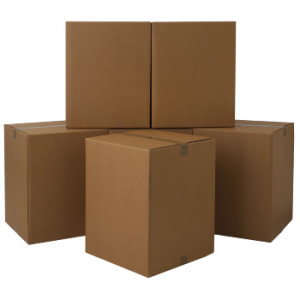Archive for the 'Moving Day' Category
People often complain about ‘hidden charges’ on their move.
While I sympathize with them, I’m also reasonably sure that somewhere in their estimating process, the moving companies either told them about extra charges for their move, or spelled out these charges in their contract.
I’m also reasonably sure that these charges weren’t highlighted in glittering gold or shouted from the mountain-top.
For example, I got a pitch from a moving company the other day via voicemail. The company went through an extensive list of things they include in their base rate. Then at the end of the call, she said: “The only things we charge for are non-reusable packing material like tape, shrink wrap, moving boxes and bubble wrap.”
In other words: most everything for packing.
Most people either don’t catch this, or they assume these charges won’t amount to much.
Then comes moving day, and they spend a couple hundred bucks on packing materials.
So when you’re planning your move, read your estimate thoroughly. Here’s a list of particular items to look for:
Packing materials: It’s often just moving boxes, tape and shrink wrap, but if you haven’t done a good job packing, this can quickly add hundreds of dollars to your moving costs. The contract should have what isn’t covered, and how much the items cost (See this article for more on moving-day packing charges.)
Moving blankets: Most companies don’t charge for this item, because they’re reusable. However, some have taken to charging RENTAL fees for them. Look for this charge.
Shuttles: If you’re in a big city, the moving company probably can’t bring a moving van into your neighborhood, and will need to shuttle stuff in a smaller truck.
Charges for stairs: You need to do two things before you move: Make sure the moving company knows about stairs at your new and old homes. And check the contract to see if they charge for stairs, and how much they charge.
Long carries: If the movers have to walk a long distance from your house to the moving van, they’ll charge for it. Just like stairs, make sure the moving companies know the layout of your new and old homes, and look for these charges in your contract. (Also, if you’re making a local move, you’re paying by the hour anyway, so you shouldn’t be paying this charge.)
Gas surcharges: Companies can levy a gas surcharge when prices are high.
Travel time: What constitutes travel time for the mover?
Credit card charges: Some moving companies levy a fee for paying by credit card. However, major credit card companies like Visa and Mastercard do NOT permit merchants to do this. Check your credit card’s policy on it. If they forbid their merchants from doing it and you got charged anyways, dispute it to get the fee reversed (a fee can be significant on something as pricey as a move).
This last one isn’t a charge, but it’s a huge annoyance: Your delivery window.
Make sure you know when you will get your things. And be wary of anyone who gives you a specific day.
For long distance moving, it’s impossible to be precise for when you’ll get your items: there are the hazards of the road, and the movers might be making stops on the way to pick up other items to fill their truck (this is a common part of moving and nothing to fear).
However, it’s very important to check your contract.
The moving company must give you a window of when you’ll get your things. And if you don’t get your things within that window, it should spell out any compensation that is due to you for hotel rooms, etc.
Check closely: I heard from a reader who said they found the delivery window buried in a section about furniture disassembly.
I don’t know if it’s true, but it should hammer home the point:
READ YOUR MOVING PAPERWORK!
Oh, and do it BEFORE moving day.
Related Stories:
Five Easy Ways to Save $1000 on Your Moving
8 Major Mistakes When Picking a Moving Company
Don’t Commit These Moving Day Sins

Psst, wanna hear a little secret about moving?
It’s not the moving charges that will kill you — it’s the packing charges.
That’s right: moving boxes, shrink wrap and tape. (Yes, tape.)
If you’re doing your own packing, you probably don’t think you need to worry about packing — you did it all yourself, right?
But you probably didn’t box some things that need to be boxed. You probably didn’t use shrink wrap on upholstered furniture. You might not have taped your boxes securely enough.
The movers will want you to do all this because they want to keep your belongings safe during the move, and make your move more efficient.
And if you haven’t done it, they’ll do it for you on moving day — and they’ll charge you for it.
Now, not all moving companies will insist on billing you for your packing materials. But some will. When you get estimates from movers, you need to ask them what’s considered extra, and what is not.
If packing materials are extra, and you’re packing yourself, you need to make sure we’ve done a thorough enough job to avoid extra charges come moving day.
If you’re packing yourself, here’s what the movers will insist on:
* Anything that can go in a box, should be in a box — it’s easier to carry, and it’s much more efficient for the moving company to load into a moving van. See more tips on what needs to go in a moving box.
* Shrink wrap is the clear film that movers use on items that are too big to go in boxes, but still need to be protected during the move. This includes upholstered furniture. See this article on what needs to be shrink-wrapped.
* Moving tape can be expensive — some readers have told me they’ve paid up to $10 a roll. The movers will use this to seal any boxes they packed, as well as any boxes you packed if you didn’t use enough of it. See this article for other reasons movers might use tape, and what kind of tape they use.
Related Content:
Want to learn more about how to pack? Check out our video series:
Want to learn a simple packing method that will help you get and stay organized?
Learn the most common mistakes when hiring a moving company
 Ah, the humble stretch wrap.
Ah, the humble stretch wrap.
This saran wrap-like substance is used by moving companies to protect items that won’t fit in boxes and can’t be pad-wrapped (ie, protected by moving blankets).
However, just like you have to watch for crazy charges on moving day boxes, watch out for moving day charges for stretch wrap.
First off, do your movers even charge for it? Many companies, particularly the van lines, do not. Moving companies don’t use much of it, so stretch wrap is a minor expense and they don’t pass the cost on to the consumer.
However, some companies do charge for this. And it can be hefty – I heard from one woman who said she got charged $1 a yard. Compare that to a large roll that you can buy yourself for 5 cents a yard.
If your moving company does charge, you can wrap items yourself to save on the expense (whether they charge for it should be broken out on your contract; I’d also ask specifically WHAT materials they charge for).
Which items will the moving companies want stretch-wrapped?
* Any upholstered furniture or headboards
* BBQ grills so that no grease gets on anything else
* Lawn furniture to protect from scratches
* Children’ s toys
* Some tools
And that’s, um, er, a wrap.
Related Articles:
Major Mistakes When Choosing Movers
5 Easy Ways to Save Over $1,000 on Your Move
3 Moving Scams You’ve Never Heard Of
 To save money on their relocation, many people are doing their own packing.
To save money on their relocation, many people are doing their own packing.
However, this can be a source of confusion and problems with moving companies when it comes to moving day — and it could cost you.
Moving companies want to be able to move things as quickly as possible out of your house and get it on the moving truck. Once on the truck, they need to be able to load thSAe truck like they’re putting together a puzzle so your items fit snugly.
The easiest way to do this is by using uniform, sturdy moving boxes.
Not only does this make the move go more smoothly and efficiently, it also cuts down on the risk of damage to your items, because a box is just a more stable way of moving things with less risk of dropping it.
So if it can go in a box, put it in a box.
If it’s not in a box, the movers will box it for you on moving day – and charge you for it, creating a sometimes hefty extra charge you hadn’t planned for.
We’ve created a list of items that customers often incorrectly leave unboxed. It’s generally anything that cannot be stacked evenly when loading the truck — for example, a statue that cannot be square with the stacked boxes.
* Clothes: Many people will put these in trash bags. They need to go in boxes. Trash bags easily rip and create a mess and they don’t stack neatly in the moving van.
* Stools and furniture small enough to fit into a box
* Lamps and shades
* Throw pillows and bedding
* Small rugs
* Fireplace equipment
* Tools
* Pictures and paintings
* Curtains and window treatments
* Children’s toys
* Vases and planters
Also, don’t try to pack items in small boxes. Some customers will pack things in shoe boxes, or they’ll pack collectibles like figurines into their original packaging.
It’s fine to do that, but those small boxes are a hassle for your mover to carry, they’re easy to drop, and they can’t be stacked neatly on the moving van. So consolidate them into a larger moving box.
Related Stories:
This is a guest article from MovingDayBoxes.com
It’s crunch time, do or die: You have to move this weekend and you haven’t done anything. You need to start packing but you don’t know where to begin, and the whole thing seems completely overwhelming. Take a deep breath — we’ll show you how to pack like a pro.
Divide your clothes into four categories:
1.) Clothes you will use before you move
2.) Clothes you will definitely be wearing in the weeks after you move
3.) Clothes that are off season
4.) Clothes that you are ready to donate.
Pack up the donation clothes first — be aggressive here, when was the last time you wore that ugly olive sweater? Purging your closet of the things you don’t wear anymore will give you a feeling of progress and the positive momentum to keep moving forward.
Pack up the clothes that are off-season and the clothes you won’t be wearing in the next two weeks next. Leave the clothes you will be wearing in the next two weeks in the closet and pack those the day of the move.
Order some affordable moving supplies that can be delivered for free the next business day. On average, somebody who is moving spends two and half hours trying to locate moving boxes, comparing prices and picking up the boxes. Save yourself this step get the boxes delivered for free.
Pack dresses, suits, and pants that can’t be wrinkled in wardrobe boxes. This is important because if an important garment is thrown in a regular moving box, they can be so thoroughly wrinkled that they make become hard or impossible to un-wrinkle.
A common novice mover mistake is to purchase many extra-large boxes. This is a mistake because as you fill an extra-large box they often become too heavy to carry. A good rule of thumb is to use as small a box as possible and use more of them. Small boxes also won’t obscure your vision as you are going down stairs or walkways.
Make sure to put your mattress in a heavy-duty mattress bag. Mattresses tend to get very dirty and grimy during a move. They are dragged from spot to spot because they are difficult to carry.
Lastly, enlist friends to help you. Perhaps somebody can watch your pets and/or kids the day of the move and Don’t forget to keep your cell phone charger handy often this gets packed into a box early on and when you need to talk with your mover they can’t reach you because your phone is out of batteries. Good luck!

Loading a rental truck often looks like a rugby scrum gone bad: all the helpers wildly throwing stuff in the truck, making the packing inefficient, and exposing your stuff to damages because of shifting in the truck while you’re moving.
Many people look to save a buck by eschewing moving companies, but it’s all for naught if your stuff is destroyed or you have to make two trips because of lousy loading.
There’s an easy fix: Have one person in charge. It’s their job to direct where items go on the truck. They should stand in the back of the truck as helpers bring in items, and then decide where they go in the truck.
While you might mock this person for not having to do as much heavy lifting, they’ve actually got the most important job of the bunch: their work will ensure that you get everything loaded in the truck, and that it all shows up at your new home in one piece.
Here are some tips to keep in mind as you load the rental truck:
Your First Steps
To make everything more efficient, get everything you need to load your truck before you begin actually loading.
Make sure all the moving boxes you’re putting in the truck are fully packed — top to bottom and side to side. If there’s empty space, fill it with enough paper so they don’t get crushed if other items are stacked on them in the truck.
Stretch-wrap sofas to protect them from dirt, or punctures. Also do mattresses and other soft items, or buy boxes or mattress bags for them.
Have enough padded materials (moving blankets) on hand to wrap furniture for protection. Wrapping furniture makes it easier to load tightly in the truck without hurting it. Try to load stuff tightly to prevent items jostling against one another during the move.
Loading It
Start loading at the front of the truck or van and work your way toward the back.
Stack items from floor to ceiling, and try to fill every space needs to be filled so no items shift during transportation. Boxes should be used as filler for open spaces.
Put heavy items lower on the truck, with lighter items on top of those.
Pack each ‘row’ fully (floor to ceiling), before moving on to the next row.
You might need to disassemble some things to ensure safe transport, like removing legs from tables. Don’t get lazy on this point, you could cause some real damage.
Sofas and some other pieces may be placed on their ends to achieve a tightly loaded truck, but you will need to be sure to place the items next to items that will not cause damage. And if the fabric, they need to be wrapped.
If you don’t use the entire truck, secure the back of your shipment with loading straps to keep things from sliding backward. When you rent your truck, make sure these things are available.